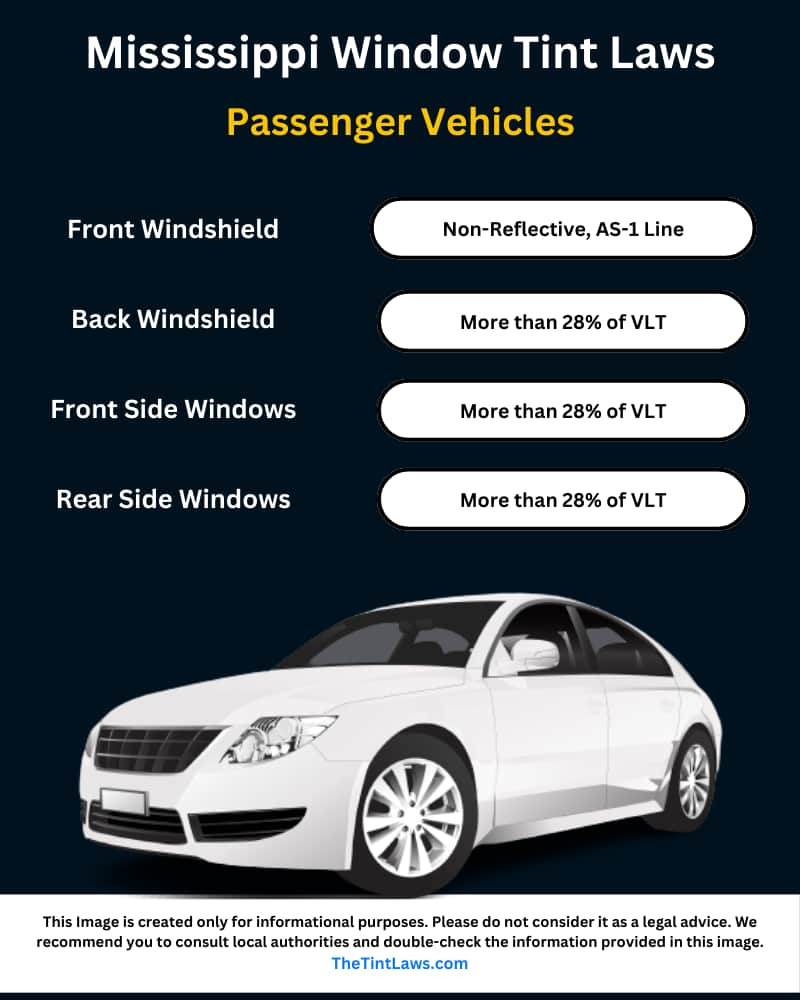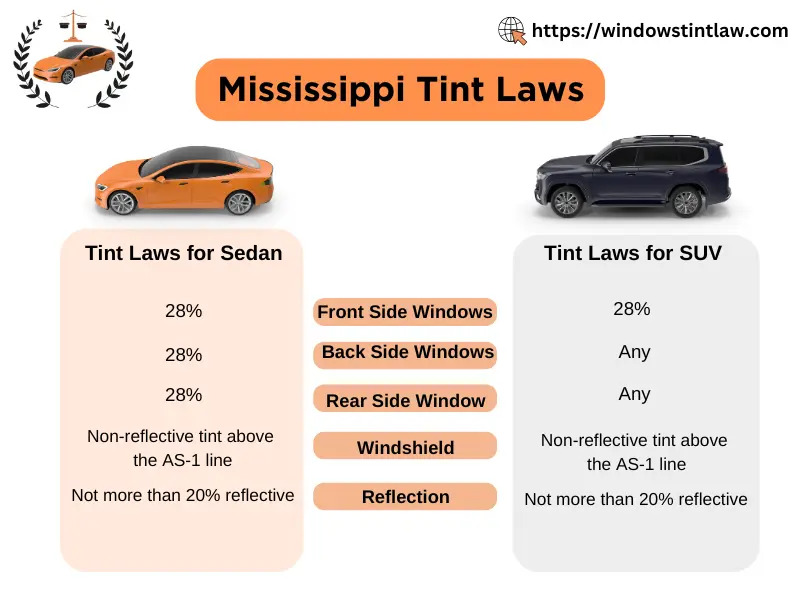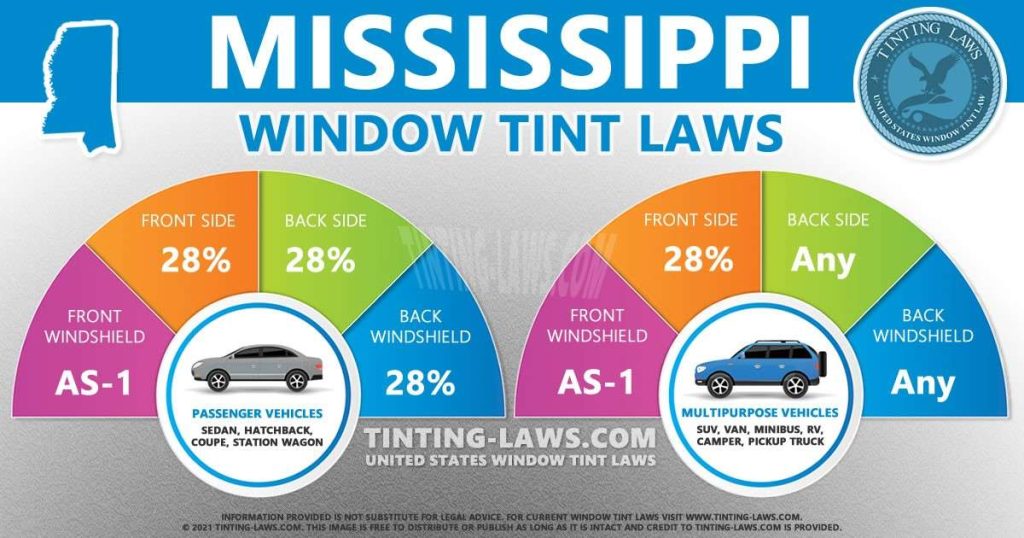Are you planning to tint your car windows in Mississippi? Before you make any changes, it’s crucial to understand the state’s tint laws.
These regulations can impact your vehicle’s appearance and your driving experience. Knowing the specifics can prevent you from facing fines or even being asked to remove your tint. As you dive into this article, you’ll discover everything you need to know about Mississippi’s tint law.
From legal limits to exceptions, we’ll guide you through each detail. Stay informed and ensure your car stays compliant and stylish. Let’s explore how Mississippi’s tint law affects you and what you should consider before visiting the tint shop.
Understanding Tint Laws In Mississippi
Tinting your car windows can be a game-changer, offering privacy and a sleek look. But before you rush to the nearest tint shop in Mississippi, it’s crucial to understand the state’s tint laws. This knowledge can save you from fines and ensure your ride stays legal and stylish. Let’s dive into what you need to know.
Legal Tint Limits In Mississippi
Mississippi has specific laws regarding how dark and reflective your window tint can be. For sedans, the front side windows must allow at least 28% of light in. The rear windows can be darker, allowing only 15% of light. SUVs and vans have similar rules, but they offer more flexibility for rear windows.
These limits are set to ensure safety on the road. Imagine driving at night with overly tinted windows—your visibility drops significantly. Understanding these limits helps you avoid these risky situations.
Why Tint Laws Matter
Tint laws aren’t just arbitrary rules. They play a vital role in road safety and law enforcement. Dark tints can obscure vision, making it harder for drivers to see pedestrians or other vehicles. They also affect how easily law enforcement can see inside vehicles during stops.
Consider how you feel when you can’t make eye contact with the driver next to you. It can be unsettling, right? Tint laws help maintain a balance between privacy and safety. They ensure you can enjoy the benefits of tinting without compromising road safety.
Consequences Of Illegal Tint
Driving with illegal tint can lead to fines and mandatory removal. You might think it’s a minor issue, but the penalties can add up. Imagine the hassle of having to remove the tint and pay a fine. It’s not just about the cost; it’s about inconvenience.
Plus, having to remove tint can damage your windows. You might need professional help to fix it, leading to more expenses. It’s wise to adhere to the tint laws from the start to avoid these headaches.
Checking Your Tint Compliance
Before getting your windows tinted, ask your tint provider about their compliance with Mississippi laws. They should know the legal limits and help you choose the right tint. It’s better to be proactive than to face consequences later.
Additionally, consider purchasing a tint meter. This device measures how much light your windows let in. It’s a small investment but can save you from costly fines. Knowing your tint compliance gives you peace of mind.
Are you thinking of getting your windows tinted? Ensure you’re informed about Mississippi’s tint laws. This knowledge empowers you to make smart decisions, keeping your car stylish and law-abiding. What steps will you take to ensure your tint is legal and safe?

Credit: thetintlaws.com
Legal Tint Percentages
Understanding Mississippi’s tint law is crucial for drivers. Legal tint percentages ensure safety and compliance on the road. These laws regulate how dark or reflective your vehicle’s windows can be. Each window type has specific guidelines. Let’s dive into the details.
Front Windshield Regulations
The front windshield must allow more light. Only a tinted strip is allowed on the top. This strip cannot extend more than five inches down. It helps reduce glare without impairing visibility. Clear visibility is essential for safe driving.
Front Side Windows Requirements
Front side windows have strict rules. They must allow over 28% of light inside. This ensures clear views for drivers. Keeping these windows light enhances road safety. Violating these rules can lead to fines.
Back Side And Rear Window Standards
Back side and rear windows have flexible standards. Drivers can use darker tints here. They need to allow more than 20% light. This provides privacy and comfort inside the vehicle. Following these standards prevents legal issues.
Exceptions And Special Cases
Understanding Mississippi’s tint law can be complex due to various exceptions. Some vehicles and individuals qualify for special considerations. These exceptions provide flexibility while maintaining legal standards. Knowing these can help you comply with the law.
Medical Exemptions
Medical exemptions allow for darker tints in certain cases. Individuals with specific medical conditions may qualify. Conditions that require limited sun exposure are considered. A physician must certify the medical need. This documentation should be kept in the vehicle at all times. It ensures easy verification if questioned by law enforcement.
Vehicles With Factory Tint
Factory tints present another unique situation. Many vehicles come with pre-installed tints. These are often within legal limits. However, it’s important to ensure compliance with state law. Factory tints can vary by manufacturer. Always check your vehicle’s specifications. Confirm they meet Mississippi’s tint regulations. This prevents potential legal issues and fines.

Credit: windowstintlaw.com
Penalties For Non-compliance
Understanding Mississippi’s tint law is crucial for car owners. Non-compliance can lead to penalties. Awareness is key to avoiding these consequences. Let’s explore the penalties for not following the tint law.
Fines And Tickets
Car owners can face fines for illegal window tinting. Tickets might be issued during routine stops. Fines vary based on the violation’s severity. Repeat offenses could lead to higher fines. Paying fines promptly helps avoid further complications.
Impact On Insurance
Illegal tinting can affect car insurance rates. Insurance companies may view tinted windows as risky. This could lead to increased premiums. Non-compliance might result in coverage issues. It’s important to keep tint within legal limits.
Tips For Choosing Legal Tint
Understanding Mississippi’s tint law is key to avoiding fines. Mississippi allows 28% visible light transmission for car windows. Ensure your tint meets this requirement for a legal and safe drive.
Choosing the right tint for your vehicle windows in Mississippi is not just about style—it’s about adhering to the state’s tint laws to avoid fines and ensure safety. Navigating these regulations might seem daunting, but with the right guidance, you can make informed decisions that enhance your driving experience while staying within legal limits. Here are some practical tips to help you choose the perfect tint for your car.Selecting The Right Tint
When selecting window tint, consider both aesthetics and functionality. Mississippi law specifies that the front side windows must allow more than 28% of light in, while the back side and rear windows can be darker, with a minimum of 15% light transmission. This means you have the freedom to choose slightly darker tints for the rear, enhancing privacy without breaking the law. Reflect on your driving habits. Are you often driving at night or in poorly lit areas? A darker tint might reduce visibility in these conditions, so balance your need for style with practical safety. Check the tint’s heat rejection properties. Tints that effectively block UV rays can protect your car’s interior and keep it cooler. Opt for high-quality films that offer good heat rejection and UV protection.Consulting Professionals
Before finalizing your decision, consult with professionals. Reputable tinting services can provide valuable insights into the best types of tint for your vehicle while ensuring compliance with Mississippi laws. You might feel tempted to DIY, but professional installers have the expertise to apply the tint flawlessly. They can prevent common issues like bubbling or peeling, ensuring a clean, long-lasting finish. Ask questions about the tint options they offer. Do they have certifications or warranties? Understanding these details can save you from future hassles and ensure you’re getting the best value for your investment. Ultimately, choosing the right tint is about finding a balance between personal preference and legal requirements. Take your time, do your research, and seek expert advice. This way, you can enjoy a stylish ride while staying on the right side of the law.
Credit: www.tinting-laws.com
Maintaining Tinted Windows
Maintaining tinted windows can be a straightforward yet crucial task for car owners in Mississippi. Proper care ensures not only compliance with tint laws but also the longevity and effectiveness of your window tint. You might wonder if there are specific techniques or tips to keep your tinted windows in top condition. Let’s dive into some practical strategies.
Cleaning And Care
Keeping your tinted windows clean is essential for maintaining their appearance and functionality. Use a gentle, ammonia-free cleaner when washing your windows. This prevents damage to the tint film.
Opt for a soft microfiber cloth instead of abrasive materials that could scratch the surface. You’ll find that regular cleaning not only enhances visibility but also helps preserve the tint’s integrity.
Have you ever noticed streaks after cleaning? Sometimes, this is due to the residue left by harsh cleaners. By choosing the right products, you minimize this risk and prolong your tint’s life.
Regular Inspections
Regularly inspect your tinted windows for any signs of damage or wear. Check for bubbling, peeling, or discoloration. These issues might indicate a problem with the application or the film itself.
Schedule inspections at least twice a year. This proactive approach keeps small issues from becoming costly repairs. You’ll also ensure your tint remains compliant with Mississippi’s tint laws.
Have you considered a professional inspection? Sometimes, an expert eye can spot potential problems you might miss. Regular inspections can save you money and keep your tint looking sharp.
Have you taken steps to maintain your tinted windows? By prioritizing cleaning and inspections, you can extend the life of your tint and stay within the law. Remember, taking care of your car is not just about aesthetics; it’s about safety and legality too.
Frequently Asked Questions
What Is The Darkest Legal Tint In Mississippi?
The darkest legal tint in Mississippi allows 28% VLT for front side windows. Rear and back windows can have 15% VLT. The windshield can have a non-reflective tint above the AS-1 line. Always check local regulations for updates.
In What State Is 20% Tint Legal?
20% tint is legal in California for rear windows, while front side windows require at least 70% light transmission. Always check local regulations for updates.
How Do I Get A Tint Exemption In Mississippi?
Apply through a licensed physician for a tint exemption in Mississippi. Obtain a medical waiver certificate. Present this certificate to the Department of Public Safety. Ensure your vehicle’s tint complies with the exemption guidelines. Keep the certificate in your vehicle at all times for verification.
Is 35% Or 20% Tint Darker?
20% tint is darker than 35% tint. The percentage indicates light transmission. Lower percentages mean less light passes through, making it darker. 20% tint allows only 20% of light, while 35% allows 35%. This makes 20% tint more effective for privacy and heat reduction.
Conclusion
Understanding Mississippi’s tint law is crucial for drivers. It ensures safety and compliance on the road. Knowing the limits helps avoid fines and legal issues. Choosing the right tint can improve comfort without breaking the law. Always check the latest regulations before installing new tint.
Professional advice can be beneficial. It helps make informed decisions about tinting. Staying updated with local laws is important. It ensures you drive safely and legally. Mississippi’s tint law protects everyone on the road. Follow it and enjoy a worry-free drive.
